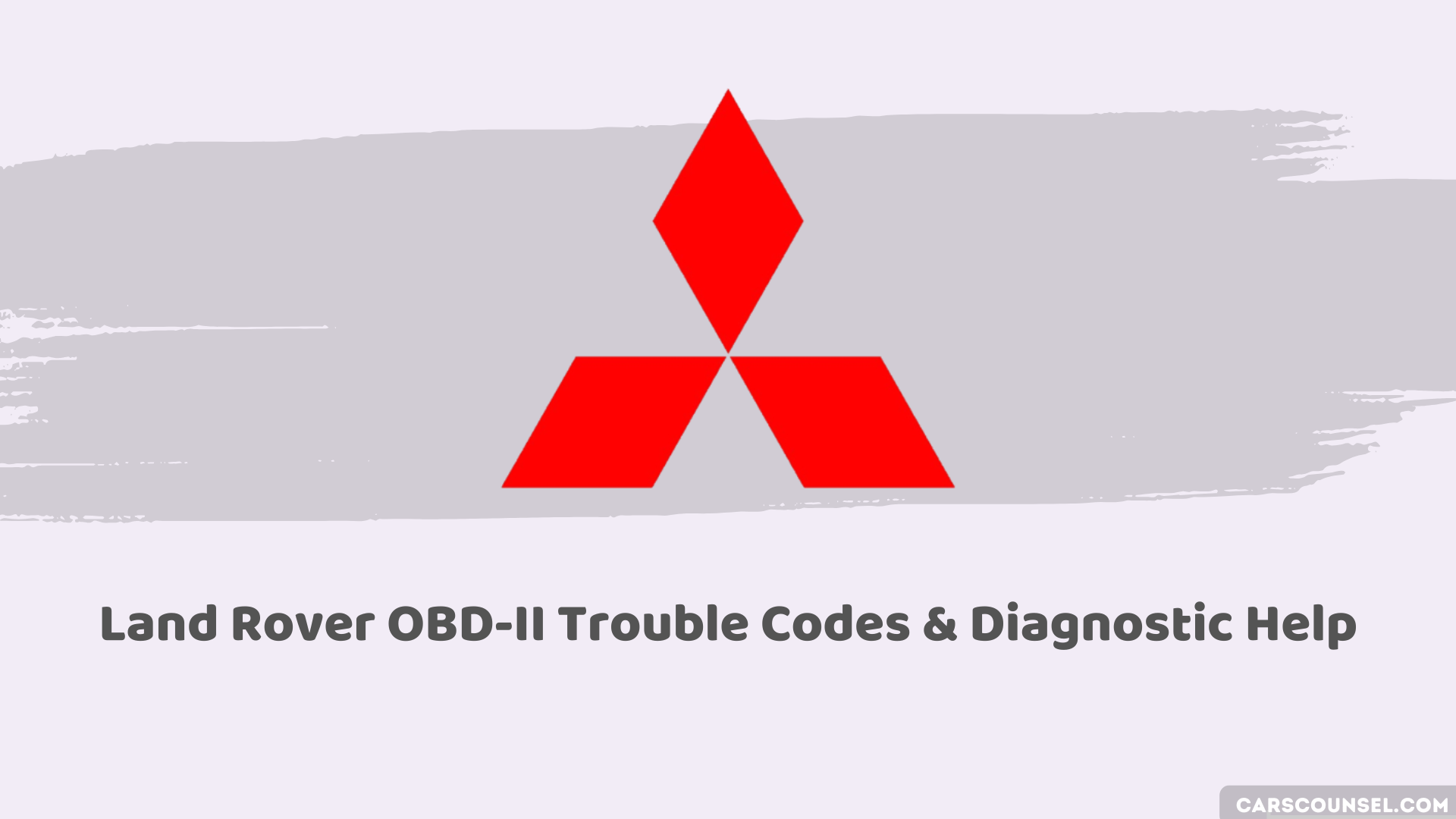You might not know that your Mitsubishi’s onboard computer is constantly monitoring its systems, ready to alert you to potential issues through a series of cryptic codes. These codes, categorized into areas like fuel and air metering or engine performance, can help you pinpoint problems and get your car running smoothly again.
But what do these codes really mean, and how do you retrieve and clear them? From P0101 to P0300, understanding Mitsubishi OBD-II codes can be a game-changer for DIY enthusiasts and mechanics alike – and we’re about to crack the code.

Quick Navigation
Mitsubishi OBD-II Code Categories
Mitsubishi OBD-II codes are systematically organized into distinct categories, making it easier to diagnose and repair vehicle issues.
The categories include Fuel and Air Metering and Auxiliary Emission Controls (P1100-P1199 and P1200-P1299), Ignition System or Misfire (P1300-P1399), Secondary Air Injection System (P1400-P1499 and P1500-P1599), and more.
These categories help you identify specific problems, such as engine performance and emissions, fuel system faults, turbocharger and boost sensor faults, cylinder injector circuit faults, and ignition misfire and knock sensor faults.
For instance, if you’re dealing with a Coolant Temperature issue, you’ll find the relevant code in the engine performance and emissions category.
Common Mitsubishi Trouble Codes
Among the numerous trouble codes your Mitsubishi’s onboard diagnostics system can generate, some are more common than others, and being familiar with these codes can save you time and frustration when troubleshooting issues. When your MIL light comes on, it’s essential to identify the underlying problem quickly. Here are some common trouble codes to look out for:
| Code | Description | Possible Cause |
|---|---|---|
| P0101 | Mass Airflow Circuit Range/Performance | Faulty mass airflow sensor |
| P0121 | Throttle/Pedal Position Sensor/Switch “A” Circuit Range/Performance | Faulty throttle position sensor |
| P0171 | System Too Lean (Bank 1) | Vacuum leaks, faulty oxygen sensor, or clogged fuel filter |
| P0300 | Random/Multiple Cylinder Misfire Detected | Faulty spark plugs, ignition coils, or fuel injectors |
| P0420 | Catalyst System Efficiency Below Threshold (Bank 1) | Clogged or faulty catalytic converter |
These codes can help you pinpoint the source of the problem, allowing you to take corrective action and get your Mitsubishi running smoothly again.
Retrieving and Clearing Codes
When your Mitsubishi’s onboard diagnostics system detects a problem, it stores a trouble code that you can retrieve using the MIL light.
To do this, turn the key to the “on” position, then turn the ignition switch to the “off” position, locate the Data Link Connector (DLC) next to the fusebox, ground the DLC terminal #1, and set the ignition switch to “on” again.
Codes are represented by a combination of illumination duration and frequency, with no codes indicated by the MIL illuminating for 0.5 seconds, then staying off for 0.5 seconds, repeating until the ignition is turned off.
For example, code 13 is indicated by the MIL illuminating once for approximately 0.5 seconds, then three times for approximately 0.2 seconds with a 0.2-second delay between deflections.
Most Common Mitsubishi OBD-II Trouble Codes
| Code | Description |
|---|---|
| P1103 | Turbocharger Wastegate Actuator |
| P1104 | Turbocharger Wastegate Solenoid |
| P1105 | Fuel Pressure Solenoid |
| P1300 | Ignition Timing Adjustment circuit |
| P1400 | Manifold Differential Pressure Sensor circuit |
| P1500 | Alternator FR Terminal circuit |
| P1600 | Serial Communication Link |
| P1715 | Pulse Generator Assembly |
| P1750 | Solenoid Assembly |
| P1751 | A/T Control Relay |
| P1791 | Engine Coolant Temperature Level Input circuit |
| P1795 | Throttle Position Input circuit to TCM |
| P0115 | Engine Coolant Temperature circuit |
| P0120 | Throttle Position circuit |
| P0125 | P0125P0125Excessive Time to Enter Closed Loop Fuel Control |
| P0130 | Heated Oxygen Sensor circuit Bank 1 Sensor 1 |
| P0135 | Heated Oxygen Sensor Heater circuit Bank 1 Sensor 1 |
| P0136 | Heated Oxygen Sensor circuit Bank 1 Sensor |
| P0141 | Heated Oxygen Sensor Heater circuit Bank 1 Sensor 2 |
| P0150 | Heated Oxygen Sensor circuit Bank 2 Sensor 1 |
| P0155 | Heated Oxygen Sensor Heater circuit Bank 2 Sensor 1 |
| P0156 | Heated Oxygen Sensor circuit Bank 2 Sensor 2 |
| P0161 | Heated Oxygen Sensor Heater circuit Bank 2 Sensor 2 |
| P0170 | Fuel Trim Bank 1 |
| P0173 | Fuel Trim Bank 2 |
| P0300 | Random Misfire Detected |
| P0301 | Misfire Detected – Cylinder 1 |
| P0302 | Misfire Detected – Cylinder 2 |
| P0303 | Misfire Detected – Cylinder 3 |
| P0304 | Misfire Detected – Cylinder 4 |
| P0305 | Misfire Detected – Cylinder 5 |
| P0306 | Misfire Detected – Cylinder 6 |
| P0325 | Knock Sensor 1 circuit |
| P0335 | Crankshaft Position Sensor circuit |
| P0340 | Crankshaft Position Sensor circuit |
| P0400 | EGR Flow |
| P0403 | EGR Solenoid |
| P0139 | Heated oxygen sensor (rear) circuit. Slow response |
| P0140 | Heated oxygen sensor (rear) circuit. No activity detected |
| P0219 | Engine over speed condition |
| P0214 | Cold Start Injector 2 Malfunction |
| P0215 | Engine Shutoff Solenoid Malfunction |
| P0216 | Injection Timing Control Circuit Malfunction |
| P0217 | Engine Overtemp Condition |
| P0218 | Transmission Over Temperature Condition |
| P0220 | Throttle/Pedal Position Sensor/Switch B Circuit Malfunction |
| P0234 | Engine Overboost Condition |
| P0235 | Turbocharger Boost Sensor A Circuit Malfunction |
| P0236 | Turbocharger Boost Sensor A Circuit Range/Performance |
| P0237 | Turbocharger Boost Sensor A Circuit Low |
| P0238 | Turbocharger Boost Sensor A Circuit High |
| P0239 | Turbocharger Boost Sensor B Malfunction |

